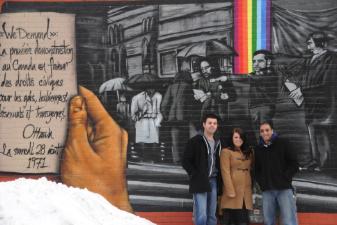After a six-year public information campaign, among other concerted efforts, he Bank St Village is officially established and Village committee chair Glenn Crawford says it’s time for him to step down.
Crawford was instrumental in envisioning and creating the gay village, which is now 12 square blocks along Bank St that are set aside for all things queer.
“I’ve been very grateful to do the work. But it’s time for other people to shape the Village for the future,” he says. “It’s about celebrating the accomplishment and stepping back for others to move it forward. I’m very happy to be a part of this community, and it’s going to be an exciting next phase.”
Crawford reminds that it’s still early days for the Village. He says people should stay tuned for more development in 2012.
“There are a number of things going on at the moment. We’ve increased visibility and garnered support from businesses and helped develop two major public art projects. Now that we have established it, it’s about growing it,” he says.
“We are in the process of putting together an online survey and planning a public community meeting for citizens and business owners alike to have an opportunity to ask questions and share thoughts. It’s a two-tier process. We need to determine what our new mission and vision is and what our first major steps are going to be in the new year.”
But what do local residents think of the new image for the community?
The gay community already knew the area as its home, but with the official designation, one member of Ottawa’s younger generation says he now feels part of a safe and protected community.
“Now we have a place where gay people and couples can walk down the street together. You can feel proud and comfortable because so many other people get it,” says young professional Daniel Head.
Somerset Councillor Diane Holmes has long supported the creation of a gay village.
“I think the Village is good for Bank St,” Holmes says. “All the studies have shown such villages in other cities are financially beneficial. The GLBT community has disposable income and spends more than the average shopper. The real estate values go up in a gay village,” she says. “Now that the signs are up, I hope we will see the community expand businesses and put up more flags.”
However, Crawford says the fight to create a gay neighbourhood took years because it was originally opposed by businesses.
“The Bank St BIA was the most concerned stakeholder,” says Crawford. “I don’t think it came from malicious or negative perspectives, but it took us six years to explain what our vision and mission was — clearing misunderstandings.”
Comparatively speaking, the creation of a gay village in Ottawa took longer than other Canadian cities, such as Montreal, Vancouver and Toronto, which have had established gay neighbourhoods for many years.
“It’s a way to put us on the map within the metropolitan scene,” says Head. “Also, the Village is so close to Parliament, within a few blocks of where legislation has been passed to promote gay rights in Canada. It’s a good sign.”
But Head says that despite progress to battle homophobia, there are still reports of members of the queer community being harassed in ByWard Market and other parts of downtown.
“The Village is an area that we won’t be heckled,” he says. “If you’re not comfortable with gay culture, you shouldn’t make other people feel that way. You would look like an idiot heckling in the Village. The Village is gay friendly. You can be yourself because there are supporters there.”

 Why you can trust Xtra
Why you can trust Xtra


